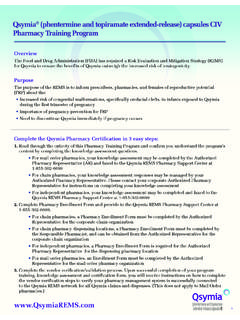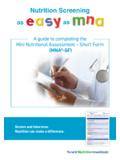Transcription of Identifying vulnerable persons at risk from fire
1 Suffolk FRS NFCC Guide 2017 v1 1 Identifying vulnerable persons at risk from fire Person -Centred Fire Risk assessment A Guide Contents Introduction 3 Legislation and Responsibilities 3 The Person-centred approach 4 Steps in risk assessment 5 Training and support 5 Fire Safety in the Home 6 Risk assessment checklist /form 7 Suffolk FRS NFCC Guide 2017 v1 2 Suffolk FRS NFCC Guide 2017 v1 3 National Fire Chiefs Council- Fire Safety in Specialised Housing- issued May 2017.
2 The guide does not introduce new standards or regulations, but builds on existing good practice and guidance currently in place. The guidance does not set prescriptive standards, its aim is to assist in reducing risk to the person and ultimately to the building they reside in. Definitions are wide and varied and for the purposes of the guidance Specialised Housing includes but is not limited to Sheltered or retirement housing where the residents live independently Extra care housing Supported housing Private dwellings where care is given which is not sheltered housing For the avoidance of doubt the name given to the premises is not the relevant factor in determining whether premises fall within the scope of the guide.
3 The factors to consider are the objectives for which the premises were constructed or converted, the nature of the residents or to whom the accommodation is promoted. Further clarification is offered in the legislation section. By the very definition of specialised housing, those living in specialised housing represent the most vulnerable to injury or death if a fire occurs in their accommodation. This is not related to architectural aspects of the building, but to the characteristics of the residents and their effects on the environment in which they live. This Guidance note and checklist will support those that work or communicate with the elderly and vulnerable persons in their homes to identify whether they are at risk from fire.
4 It can be used by family members, carers, and representatives of Housing Providers, Care Providers, Local Authorities and local Fire and Rescue Service Prevention teams. It provides a Checklist person-centred fire risk assessment form , which can be used for an initial quick and easy check of elderly or vulnerable residents in their own private dwellings and will provide specific and relevant information to aid risk reduction. It can also be used for Specialised Housing premises (ie Care Homes, Sheltered Housing, Extra Care and Supported Living type premises) to inform the fire risk assessment process for the whole premises and the evacuation strategy. & Responsibilities The scope of NFCC Guidance does not include buildings which include integral medical facilities or care homes such as Residential homes Nursing homes Special care homes with accommodation for dementia patients Registered premises with CQC Suffolk FRS NFCC Guide 2017 v1 4 Hostels Childrens homes Commercial premises These are addressed by existing legislation.
5 The Regulatory Reform (Fire Safety) Order 2005 (the Order), places a requirement on the responsible person to manage fire safety and to carry out a fire risk assessment . Article 9 (7)(b) states that an FRA should take into account any group of persons being especially at risk . To achieve this a person centred risk assessment needs to be carried out for the individuals identified as particularly vulnerable . Therefore, the onus is on the management to formalise a fire and evacuation strategy to enable effective fire safety procedures to be followed in the event of an emergency. This strategy must be unified throughout the building and should be inclusive of all people. person-centred approach The person-centred fire risk assessment will help identify residents who are at higher risk from fire in their own accommodation whether this is due to their behaviours or their ability to respond and escape from a fire.
6 The risk assessment should include an action plan that specifies what steps will be taken to improve the safety of the vulnerable resident. Person-Centred Fire Risk assessment is focused on 3 key areas a) An increased fire risk This concerns the residents behaviours, practices and environment such as smoking, unsafe cooking, oxygen use, emollient cream use and previous history of fires or near misses b) Ability to react to a fire or alarm Even though a resident may be able to physically escape a fire situation their understanding and ability to make safe decisions or even the ability to hear an alarm will greatly effect risk c) Ability to respond and escape a fire This concerns the physical ability to evacuate to a place of safety either through physical disability being bed bound or restricted movements, locked doors or visually impaired Completing the Risk assessment The appropriate person to carry out the person-centred fire risk assessment for a resident will depend on the circumstances of the scheme and the resident.
7 It may be carried out by specialised housing scheme managers, care providers or any other party who regularly engages with the resident. A person-centred approach should consider a safety from fire approach, such as use of fire-safe ashtrays or smoking aprons by those who smoke. The method should also consider how a fire might develop and spread causing possible harm to the occupier. Items such as fire-retardant bedding or personal water mist systems can assist in the protection of a resident at risk Suffolk FRS NFCC Guide 2017 v1 5 in a person-centred fire risk assessment There are considered to be 9 steps in a person centred fire risk assessment . These are noted below and full explanations of these are available in the NFCC Specialised Housing Guidance document.
8 Step 1: The characteristics, behaviours and capabilities of the resident that may lead to fire risk. Step 2: Determine the potential causes of fire and the existing measures to prevent fire. Step 3: Identify any circumstances that could lead to the rapid development of fire. Step 4: Identify existing measures to protect the resident if fire occurs. Step 5: Consider capacity of resident to respond appropriately to fire alarm signals or signs of fire. Step 6: Consider ability of resident to make their way to safety. Step 7: Determine the level of risk to the resident from fire. Step 8: Prepare action plan. Step 9: Determine period for review of the assessment . An initial checklist that can be carried out by a relative, care manager, scheme manager or other designated person is included in this guidance note.
9 If risks are identified this should be passed to a manager or person who has responsibility for the safety of the residents (such as the care provider or housing provider) for further action. Where such a person is not identifiable or does not exist then the checklist should be passed to the Social Care team. They may make arrangements for a more detailed assessment and referrals involving key stakeholders such as, Fire and Rescue Service, Housing and Care Providers. TSA On-line training package Fire Safety in the Home The link below takes you to the TSA on-line training package that has been developed with the London Fire Brigade. The first module focusses on Fire safety in the Home and is available as a resource to anyone who comes into contact with vulnerable people.
10 Contacts and further guidance Suffolk Fire and Rescue Service Business Support 01473 260588 Suffolk FRS NFCC Guide 2017 v1 6 A Fire Safety in The Home information booklet is available from Suffolk Fire and Rescue and can be downloaded electronically from our website. Some basic fire safety advice has also been provided below. Fire retardant bedding can include pillow cases, blankets, aprons and night clothes. Call Suffolk Fire and Rescue Service for details and advice For smokers, fire safe ashtrays may be suitable Replace petroleum or paraffin emollient based creams for water based creams for oxygen users and smokers Where possible, smoke alarms should be fitted in all areas of risk any room with electrical equipment left switched on or on standby, electrical items left on charge, anywhere where people smoke, anywhere candles or incense sticks are used.






